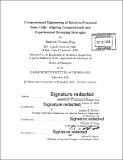| dc.contributor.advisor | Angela M. Belcher and Nicholas X. Fang. | en_US |
| dc.contributor.author | Klug, Matthew Thomas | en_US |
| dc.contributor.other | Massachusetts Institute of Technology. Department of Mechanical Engineering. | en_US |
| dc.date.accessioned | 2016-03-03T21:07:16Z | |
| dc.date.available | 2016-03-03T21:07:16Z | |
| dc.date.copyright | 2015 | en_US |
| dc.date.issued | 2015 | en_US |
| dc.identifier.uri | http://hdl.handle.net/1721.1/101534 | |
| dc.description | Thesis: Ph. D., Massachusetts Institute of Technology, Department of Mechanical Engineering, 2015. | en_US |
| dc.description | Cataloged from PDF version of thesis. | en_US |
| dc.description | Includes bibliographical references. | en_US |
| dc.description.abstract | Unlike silicon, solution-processable solar materials are flexible, lightweight, easily processed at low temperatures, and display a wide variety of colors and degrees of transparency. These attributes open new opportunities to integrate solar power creatively and inexpensively into new markets such as electric vehicles and multifunctional architecture, as well as augment the performance of current solar technology in tandem cell configurations. One of the central challenges to realizing this vision is the high degree of disorder generally exhibited by solution-processed materials, which provides an abundance of trap sites that limit carrier transport. Hence, the performance of many solution-processed materials is governed by a trade-off between light harvesting and carrier collection, where complete absorption of sunlight requires active layer thicknesses greater than the diffusion lengths of the performance-limiting charge carrier. Overcoming this compromise requires either modifying the optical and electronic properties of solar materials themselves or designing device architectures that improve charge extraction or photon management. The work presented here pursues both of these strategies by leveraging a central feature of solution-processed solar cells - the ability to control the composition of the active layer by simply blending different ingredients in the precursor solutions. This simple concept provides the opportunity to tune the chemical composition of ionic solar materials, adjust the kinetics of film formation, add passivating agents that reduce trap densities, or introduce nanomaterials with specialized functionality into the active layers. To explore this concept, two specific projects were undertaken. The first evaluates how the light harvesting ability of bulk-heterojunction systems is impacted by incorporating plasmonic nanoparticles into the material bulk. By performing a series of finite-difference time-domain (FDTD) calculations, many different active layer compositions were screened through to identify optimal optical configurations and predict performance trends. The results of this analysis informed the fabrication of actual solar cells, which generated photocurrent and external quantum efficiency enhancements consistent with the predicted trends. To fabricate several of these devices, biomolecules were used to mediate the assembly and growth of plasmonic metal-oxide nanocomposites. The second project evaluates how replacing a portion of the metal content in metal-halide perovskite solar cells with alternative non-toxic metal species impacts the photovoltaic properties of the perovskite film. Relevant electronic properties such as the material band gap and carrier effective masses were theoretically evaluated using density functional theory (DFT). By computationally screening through a series of mixed-metal compositions that spans the periodic table, several promising candidates were identified that preserve the excellent electronic properties of the methylammonium lead triiodide perovskite, MAPbI₃, while simultaneously reducing material toxicity. The computational effort was paired with an exhaustive experimental screening study that systematically evaluated how replacing various amounts of lead with nine different metal species influence material properties and photovoltaic performance. By screening through a large set of active material compositions both computationally and experimentally, favorable embodiments were encountered and the experimental results were benchmarked against the theoretical predictions to help speculate on the mechanisms responsible for observed performance improvements. | en_US |
| dc.description.statementofresponsibility | by Matthew Thomas Klug. | en_US |
| dc.format.extent | 355 pages | en_US |
| dc.language.iso | eng | en_US |
| dc.publisher | Massachusetts Institute of Technology | en_US |
| dc.rights | M.I.T. theses are protected by copyright. They may be viewed from this source for any purpose, but reproduction or distribution in any format is prohibited without written permission. See provided URL for inquiries about permission. | en_US |
| dc.rights.uri | http://dspace.mit.edu/handle/1721.1/7582 | en_US |
| dc.subject | Mechanical Engineering. | en_US |
| dc.title | Compositional engineering of solution-processed solar cells : aligning computational and experimental screening strategies | en_US |
| dc.type | Thesis | en_US |
| dc.description.degree | Ph. D. | en_US |
| dc.contributor.department | Massachusetts Institute of Technology. Department of Mechanical Engineering | |
| dc.identifier.oclc | 939923692 | en_US |
